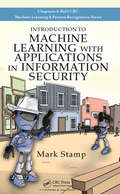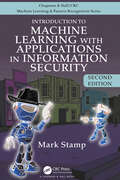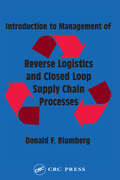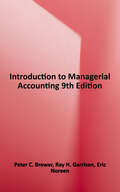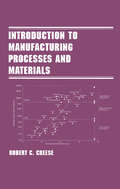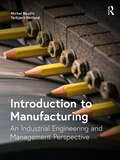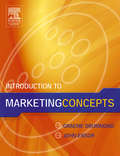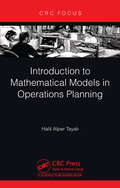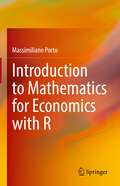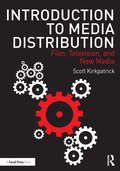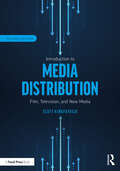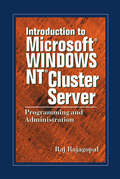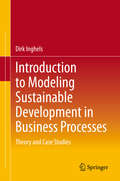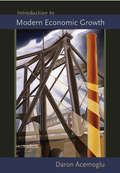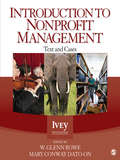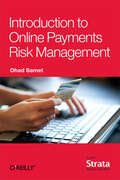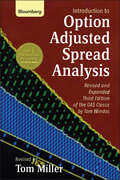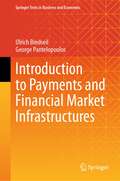- Table View
- List View
Introduction to Machine Learning with Applications in Information Security
by Mark Stamp<p>Introduction to Machine Learning with Applications in Information Security provides a class-tested introduction to a wide variety of machine learning algorithms, reinforced through realistic applications. The book is accessible and doesn’t prove theorems, or otherwise dwell on mathematical theory. The goal is to present topics at an intuitive level, with just enough detail to clarify the underlying concepts. <p>The book covers core machine learning topics in-depth, including Hidden Markov Models, Principal Component Analysis, Support Vector Machines, and Clustering. It also includes coverage of Nearest Neighbors, Neural Networks, Boosting and AdaBoost, Random Forests, Linear Discriminant Analysis, Vector Quantization, Naive Bayes, Regression Analysis, Conditional Random Fields, and Data Analysis. <p>Most of the examples in the book are drawn from the field of information security, with many of the machine learning applications specifically focused on malware. The applications presented are designed to demystify machine learning techniques by providing straightforward scenarios. Many of the exercises in this book require some programming, and basic computing concepts are assumed in a few of the application sections. However, anyone with a modest amount of programming experience should have no trouble with this aspect of the book. <p>Instructor resources, including PowerPoint slides, lecture videos, and other relevant material are provided on an accompanying website: http://www.cs.sjsu.edu/~stamp/ML/. For the reader’s benefit, the figures in the book are also available in electronic form, and in color.
Introduction to Machine Learning with Applications in Information Security (Chapman And Hall/crc Machine Learning And Pattern Recognition Ser.)
by Mark StampIntroduction to Machine Learning with Applications in Information Security, Second Edition provides a classroom-tested introduction to a wide variety of machine learning and deep learning algorithms and techniques, reinforced via realistic applications. The book is accessible and doesn’t prove theorems, or dwell on mathematical theory. The goal is to present topics at an intuitive level, with just enough detail to clarify the underlying concepts. The book covers core classic machine learning topics in depth, including Hidden Markov Models (HMM), Support Vector Machines (SVM), and clustering. Additional machine learning topics include k-Nearest Neighbor (k-NN), boosting, Random Forests, and Linear Discriminant Analysis (LDA). The fundamental deep learning topics of backpropagation, Convolutional Neural Networks (CNN), Multilayer Perceptrons (MLP), and Recurrent Neural Networks (RNN) are covered in depth. A broad range of advanced deep learning architectures are also presented, including Long Short-Term Memory (LSTM), Generative Adversarial Networks (GAN), Extreme Learning Machines (ELM), Residual Networks (ResNet), Deep Belief Networks (DBN), Bidirectional Encoder Representations from Transformers (BERT), and Word2Vec. Finally, several cutting-edge deep learning topics are discussed, including dropout regularization, attention, explainability, and adversarial attacks. Most of the examples in the book are drawn from the field of information security, with many of the machine learning and deep learning applications focused on malware. The applications presented serve to demystify the topics by illustrating the use of various learning techniques in straightforward scenarios. Some of the exercises in this book require programming, and elementary computing concepts are assumed in a few of the application sections. However, anyone with a modest amount of computing experience should have no trouble with this aspect of the book. Instructor resources, including PowerPoint slides, lecture videos, and other relevant material are provided on an accompanying website: http://www.cs.sjsu.edu/~stamp/ML/.
Introduction to Macroeconomics
by Edwin G. Dolan David E. LindseyIncludes case studies for every chapter. Also covers international economic theory and policy.
Introduction to Management of Reverse Logistics and Closed Loop Supply Chain Processes
by Donald F. BlumbergIncreasing legislative and environmental pressure requires businesses to become more responsive to products that either have been returned or that are at the end of their useful lives. Life cycles are getting shorter, and efficient handling can save large amounts of money since many materials can be extracted and reused or redistributed. Reverse lo
Introduction to Managerial Accounting
by Eric W. Noreen Ray H. Garrison Peter C. BrewerBrewer’s Introduction to Managerial Accounting has earned a reputation as the most accessible and readable book on the market. Its manageable chapters and clear presentation point students toward understanding just as the needle of a compass provides direction to travelers. However, the book’s authors also understand that everyone’s destinations are different. Some students will become accountants, while others are destined for careers in management, marketing, or finance. Not only does the Brewer text teach students managerial accounting concepts in a clear and concise way, but it also asks students to consider how the concepts they’re learning will apply to the real-world situations they will eventually confront in their careers. This combination of conceptual understanding and the ability to apply that knowledge directs students toward success, whatever their final destination happens to be.
Introduction to Manufacturing Processes and Materials (Manufacturing Engineering and Materials Processing #Vol. 54)
by Robert CreeseThe first manufacturing book to examine time-based break-even analysis, this landmark reference/text applies cost analysis to a variety of industrial processes, employing a new, problem-based approach to manufacturing procedures, materials, and management. An Introduction to Manufacturing Processes and Materials integrates analysis of material costs and process costs, yielding a realistic, effective approach to planning and executing efficient manufacturing schemes. It discusses tool engineering, particularly in terms of cost for press work, forming dies, and casting patterns, process parameters such as gating and riser design for casting, feeds, and more.
Introduction to Manufacturing: An Industrial Engineering and Management Perspective
by Michel Baudin Torbjørn NetlandThis Introduction to Manufacturing focuses students on the issues that matter to practicing industrial engineers and managers. It offers a systems perspective on designing, managing, and improving manufacturing operations. On each topic, it covers the key issues, with pointers on where to dig deeper. Unlike the many textbooks on operations management, supply chain management, and process technology, this book weaves together these threads as they interact in manufacturing. It has five parts: Getting to Know Manufacturing: Fundamental concepts of manufacturing as an economic activity, from manufacturing strategy to forecasting market demand Engineering the Factory: Physical design of factories and processes, the necessary infrastructure and technology for manufacturing Making Information Flow: The "central nervous system" that triggers and responds to events occurring in production Making Materials Flow: The logistics of manufacturing, from materials handling inside the factory via warehousing to supply chain management Enhancing Performance: Managing manufacturing performance and methods to maintain and improve it, both in times of normal operations and emergencies Supported with rich illustrations and teaching aids, Introduction to Manufacturing is essential reading for industrial engineering and management students – of all ages and backgrounds – engaged in the vital task of making the things we all use.
Introduction to Marketing
by Benson P. ShapiroA brief introduction to the nature and scope of marketing.
Introduction to Marketing Concepts
by John Ensor Graeme DrummondWritten in a user-friendly way to ensure the information is accessible, Introduction to Marketing Concepts is ideally suited to students that are faced with time-pressures yet need to gain a comprehensive understanding of the main concepts of marketing.The authors focus only on the points that are needed to be able to understand the theory, without the entanglement of additional information. This ensures students do not have to wade through non-essential information to get to grips with the subject. A balance between basic marketing and strategic concepts makes it suitable for all levels. Each chapter contains a series of vignettes to illustrate the theory, with e-marketing perspective evident throughout and a Web-based resource that accompanies the text.
Introduction to Mathematical Models in Operations Planning
by Halit Alper TayalıDiscover the intricate nature of a company's production function and the comprehensive principles of planning operations in this book. Through practical applications and enriched by numerical examples, readers gain essential knowledge of elementary mathematical methods in operations planning. The inclusion of the powerful R programming language, accompanied by code scripts and real-world examples, enhances the learning experience. Blending theory with practice, this resource equips readers with the tools necessary to optimize production systems, make informed decisions, and gain a competitive edge in today's dynamic business landscape.
Introduction to Mathematics for Economics with R
by Massimiliano PortoThis book provides a practical introduction to mathematics for economics using R software. Using R as a basis, this book guides the reader through foundational topics in linear algebra, calculus, and optimization. The book is organized in order of increasing difficulty, beginning with a rudimentary introduction to R and progressing through exercises that require the reader to code their own functions in R. All chapters include applications for topics in economics and econometrics. As fully reproducible book, this volume gives readers the opportunity to learn by doing and develop research skills as they go. As such, it is appropriate for students in economics and econometrics.
Introduction to Media Distribution: Film, Television, and New Media
by Scott KirkpatrickIntroduction to Media Distribution offers a clear, direct and comprehensive overview of the entire film, television and new media distribution business, valuable to both students and professionals. In this book, author Scott Kirkpatrick draws from over a decade of personal experience in the distribution arena to explore what fuels the distribution process, and explains in real-world terms how the business works from beginning to end—not merely what happens to a film or television series after a distributor acquires it, but how distributors develop, pre-sell and broker deals on content before it even exists. Kirkpatrick covers deal structures, release strategies, acquisition approaches, rights sales, international co-productions, tax credits, audience research, global regulatory boards, and even ‘behind closed doors’ monetization practices. The book offers: A straightforward, clear and insightful approach to understanding the fundamental basics of how the global distribution marketplace works, and how distribution companies actually operate and create the content they need; An insider’s analysis of all levels of the business with an emphasis on the independent scene, the root from where development in the industry grows; A comprehensive overview of how film and television markets and festivals work, and how buyers and sellers actually broker deals in the field; Detailed explanations of how each media right is defined and windowed to maximize potential revenue; A detailed overview of several major international territories, and how each operates within the context of the global media business; Guidance and advice from an industry expert on how one can initiate their professional career in the entertainment industry, applicable to individuals in all roles; A robust appendix containing in-depth studies of legal definitions, material delivery requirements, territory-by-territory financial projections, and more. An accompanying eResource offers template contracts, sample agreements, and further resources for download.
Introduction to Media Distribution: Film, Television, and New Media
by Scott KirkpatrickIn this second edition, author Scott Kirkpatrick draws from over a decade of personal experience in the distribution arena to provide a clear and up-to-date overview of the entire film, television, and new media distribution business. Readers will learn what fuels the distribution process and exactly how the distribution business works from beginning to end—not merely what happens to a film or television series upon acquisition, but how distributors develop, presell and broker deals on content before it even exists. This new edition considers a much more international approach to media distribution, with case studies and analyses from across the globe. It also reflects on the ever-increasing relevance of diversity and inclusiveness in the industry, as well as the new media verticals like podcasts and the effects of social media influencers on the media landscape. The book will be an integral guidebook for any student or professional wishing to understand both the basics and the subtleties of media distribution. The book also contains a robust appendix containing in-depth studies of legal definitions, material delivery requirements, territory-by-territory financial projections and more.
Introduction to Metaverse: Technology Landscape, Applications, and Challenges
by Rajan Gupta Saibal K. PalThis book discusses Metaverse Technology, which is one of the emerging technologies around the world, through its concepts, definitions, architectural layers, economic implications, and presents comparison points with other allied areas like Web 3.0, Digital Twin, Blockchain, Multiverse, Artificial Intelligence, Internet of Everything and Hyperautomation.The book also presents several use-cases and adoption areas of Metaverse technology, along with global outlook of top companies implementing this technology through major platforms and tools. The potential use of this technology for Public Sector is also explored in this book, apart from the suggested business framework for its adoption. Potential misuse and ethical concerns have also been summarised. This introductory book on Metaverse, written with a multidisciplinary approach, will provide readers with a clear understanding of what the Metaverse is, what technologies are involved in its creation, and its current as well as potential future applications, in a very simple manner.
Introduction to Microsoft Windows NT Cluster Server: Programming and Administration
by Raj RajagopalMastering cluster technology-the linking of servers-is becoming increasingly important for application and system programmers and network designers, administrators, and managers. With Microsoft's Windows NT cluster server being the first to tie cluster technology with a major operating system, it appears destined to take a leadership position in th
Introduction to Modeling Sustainable Development in Business Processes: Theory and Case Studies
by Dirk InghelsSustainable development and corporate social responsibility drive countries, regions, and businesses to take environmental and social concerns into account when realizing economic objectives. A growing awareness of the connectedness between industrial, societal, and environmental systems might shift the way businesses will be operated. This book aims to help students and business practitioners use quantitative modeling in their pursuit to make business processes sustainable. Two approaches are introduced: linear optimization and system dynamics. Moreover, the quantification of the three different sustainability objectives is also addressed. Next to introducing the theoretical background, many real-life examples are discussed to demonstrate how the modelling techniques can be applied.
Introduction to Modern Economic Growth
by Daron AcemogluIntroduction to Modern Economic Growth is a groundbreaking text from one of today's leading economists. Daron Acemoglu gives graduate students not only the tools to analyze growth and related macroeconomic problems, but also the broad perspective needed to apply those tools to the big-picture questions of growth and divergence. And he introduces the economic and mathematical foundations of modern growth theory and macroeconomics in a rigorous but easy to follow manner. After covering the necessary background on dynamic general equilibrium and dynamic optimization, the book presents the basic workhorse models of growth and takes students to the frontier areas of growth theory, including models of human capital, endogenous technological change, technology transfer, international trade, economic development, and political economy. The book integrates these theories with data and shows how theoretical approaches can lead to better perspectives on the fundamental causes of economic growth and the wealth of nations. Innovative and authoritative, this book is likely to shape how economic growth is taught and learned for years to come. Introduces all the foundations for understanding economic growth and dynamic macroeconomic analysis Focuses on the big-picture questions of economic growth Provides mathematical foundations Presents dynamic general equilibrium Covers models such as basic Solow, neoclassical growth, and overlapping generations, as well as models of endogenous technology and international linkages Addresses frontier research areas such as international linkages, international trade, political economy, and economic development and structural change An accompanying Student Solutions Manual containing the answers to selected exercises is available (978-0-691-14163-3/$24.95). See: http://press.princeton.edu/titles/8970.html. For Professors only: To access a complete solutions manual online, email us at: acemoglusolutions@press.princeton.edu
Introduction to Mutual Funds
by Robert C. PozenThis note is an excerpt from Professor Bob Pozen's book "The Mutual Fund Business" and is an introduction to mutual funds, contrasted with commercial banks.
Introduction to Nonprofit Management: Text and Cases
by W. Glenn Rowe Mary Conway Dato-onIntroduction to Nonprofit Management: Text and Cases is a unique collection of 28 cases from Ivey Publishing at the Richard Ivey School of Business. This casebook helps students gain a better understanding of nonprofit management by providing contemporary cases from around the world, illustrating the complexity of nonprofit management in a variety of different sectors. Each chapter begins with a substantive introduction to the chapter topic by the editors. The book matches cases to the key concepts in nonprofit management, allowing students to discuss the outcomes and consider the reasons for success or failure. In addition to covering topical issues for managing a nonprofit organization, the book also discusses current trends in the field such as social entrepreneurship, earned income strategies, advocacy, lobbying and leadership.The SAGE Text and Cases Series, featuring IVEY Cases, is a co-publishing partnership between SAGE and the Richard Ivey School of Business at The University of Western Ontario. Due to their popularity in more than 60 countries, approximately 200 new cases are added to the Ivey School of Business library each year. These affordable collections not only help students connect to real-world situations, but also benefit a professional readership seeking continued education in the field.
Introduction to Oil Tanker and Gas Carrier Operations
by Alexander Arnfinn OlsenIntroduction to Oil Tanker and Gas Carrier Operations introduces the mandatory minimum requirements for training and qualifications for masters, officers and ratings serving on-board liquefied gas tankers. It covers basic safety and pollution-prevention precautions and procedures, layouts of several types of liquefied gas tankers, types of cargo, their hazards and their handling equipment, as well as general operational sequence and liquefied gas tanker terminology.The book is intended for officers and key ratings who have not previously served on board crude oil or liquefied gas tankers as part of the regular ship’s company. It covers the Level 1 training requirements prescribed by Regulation V/1, paragraph 1.2 of the International Convention on Standards of Training, Certification and Watchkeeping for Seafarers, STCW-95.
Introduction to Online Payments Risk Management
by Ohad SametIf you've been tasked with building a team to handle risk management for online payments (RMP), this practical introduction provides a framework for choosing the technologies and personnel you need. Author and financial services executive Ohad Samet explains the components of payments risk management, and presents a coherent strategy and operational approach.You'll learn the answers to questions you're likely to encounter in the first 18 months of operation, with information that Samet has shaped and tested over several years in the industry. This book is ideal whether you intend to be a one-person task force or work with dozens of agents and analysts.Use both a portfolio and behavioral approach to analyzing and optimizing lossesLearn about your customers to determine if they can and will meet obligationsBuild an RMP team for payment risk operations, analytics, and decision automationUse linking mechanisms and velocity models to detect unusual activity among your customersDesign system and data architecture to facilitate your activity analysisImplement the decision and loss-reduction mechanisms you need to act on your findings
Introduction to Option-Adjusted Spread Analysis (Bloomberg Financial #46)
by Tom MillerTop traders, investors, and analysts agree that one method, option-adjusted spread (OAS) analysis, is the most useful way to compare and value securities with options. Nearly every day the bond market figures out a new way to structure securities, most of which involve options. This book explains OAS analysis in plain English, presenting each step in the method clearly and concisely. Topics covered include: Why yield-based analysis breaks down for nonbullet bonds How to model put and call provisions as embedded options How to distinguish the intrinsic and time components of option value How to model interest-rate volatility, future interest rates, and future bond prices How to calculate option-free price and yield How to estimate the "fair value" of a bond How to calculate implied spot and forward rates Salespeople, traders, and investors will want to read this book and keep it on their desks.
Introduction to Organizational Behavior and Management (4th Edition)
by Chuck Williams James Campbell Quick Debra L. NelsonLearn more about how people behave in organizations, and how to manage them for greater productivity and worker satisfaction.
Introduction to Patents and Trade Secrets
by Josh LernerProvides an overview of patent and trade secret protection. Also discusses the legal processes through which intellectual property is protected and litigated.
Introduction to Payments and Financial Market Infrastructures (Springer Texts in Business and Economics)
by Ulrich Bindseil George PantelopoulosPayments and financial market infrastructures are vital components of modern economies, yet they have often been overlooked by economists. However, any economic exchange, including financial market transactions, is matched by a payment leg, and the safety, efficiency, and immediacy of the payment, and the problem of linking the two legs of the transaction (“delivery-vs-payment”), remain universal challenges. The consequences of inefficiencies or interruptions in payment and settlement systems have immediate and significant impacts on the real economy. Moreover, payments and financial market infrastructures are also a matter of strategic importance for nation-states, and being excessively dependent on foreign providers has been proven to be a significant risk, as they can be “weaponized."This book provides a concise yet thorough introduction to payments and financial market infrastructures, exploring various types of risks, retail payments, payment systems, cross-border payments, central counterparties, FX operations, and central securities depositories. The final chapter investigates payment innovations, including unbacked crypto-assets (e.g. Bitcoin), stablecoins, and central bank digital currencies. The text outlines key activities and risk management frameworks, as well as examining the operational mechanics of different payment systems. The book emphasizes the importance of understanding the nature of transfer of financial claims and liabilities through the process of payment and settlement, providing financial account representations of payments wherever useful. The book concludes that the payment and financial market infrastructure space has been shaken by recent innovations, which are expected to lead to seismic shifts in payment technology, practices, and market structures.
